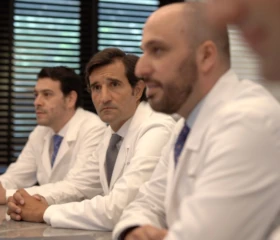Diagnosis Prostatitis
The diagnosis of prostatitis includes ruling out other pathologies.
A good diagnosis of prostatitis will detect the cause in order to apply the most effective treatment.
- Super-specialized urologists
- Personalized treatment
- Minimally invasive approach
- More than 16,000 patients successfully treated
Diagnosis of prostatitis
The diagnosis of prostatitis, in addition to being based on the patient's clinical history, includes ruling out other pathologies as a cause of the symptoms and determining the type of prostatitis the patient has. This will be determined by performing some of the following tests:
- Physical examination (rectal examination).
- Fractionated urine culture. It is based on the separate collection of different specimens of urine and prostatic secretions.
- Semen culture. It consists of analyzing the semen to look for possible infections caused by bacteria, fungi or other microorganisms.
- Blood tests.
- Prostate massage. In some cases, the prostate may be gently massaged during a digital rectal examination to release prostatic fluid into the urethra. A urine sample after the massage expels the prostate fluid for bacterial testing.
- Ultrasound. In some cases, an ultrasound of the prostate may be requested.
If initial tests show no signs of infection, it may be indicated to others such as:
- Urodynamic study. A variety of tests may be used to check how the bladder and urethra are doing in terms of urine retention and release.
- Imaging. Imaging tests may be ordered to identify prostate irregularities, abnormal growths or other problems in the pelvic area that may be contributing to the pain.
They ask us in the Consultation
Where does it hurt when there are prostate problems?
When prostate problems are present, pain may manifest in various areas of the body depending on the specific condition and its severity. The most common causes of pain are prostatitis and advanced prostate cancer. The following are the areas where pain may occur: - In the perineum (area between the anus and the genitals): when there is prostatitis. - Lower abdomen, especially if there is urinary obstruction due to an enlarged prostate. - Lower back: in advanced prostate cancer, pain may radiate to the lower back due to bone metastases. It may also appear in chronic prostatitis due to persistent inflammation. - Groin and inner thighs: some prostate conditions may cause pain radiating to the groin or inner thighs due to pressure on nearby nerves. - Testicles and penis: some forms of prostatitis may cause pain in the testicles or base of the penis, as inflammation can affect nearby nerves and tissues. - Anus or rectum: The prostate is very close to the rectum, so inflammation may cause rectal pain or a feeling of pressure. It may be felt more when sitting for long periods of time.
How do shock waves work in the treatment of prostatitis?
Shock waves help regenerate blood vessels in the perineal muscles, which reduces prostate inflammation and muscle contractures and increases blood flow to the prostate gland.
Is acupuncture effective in treating prostatitis?
Acupuncture improves the symptoms of prostatitis and can be considered an effective and safe therapeutic alternative.
Team of the Prostatitis Unit
Newsof ROC Clinic in Prostatitis
Research
Registry of patients with chronic prostatitis CP/CPPS undergoing treatment with 448 khz radiofrequency therapy.
Technology
The Aries® 2, from Dornier MedTech, combines design with effective EMSE electromagnetic shock wave generation technology.


 +34 912 627 104
+34 912 627 104 Contact
Contact








